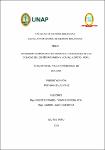Diversidad comparativa de primates en aguajales de las cuencas de los ríos Marañon y Ucayali, Loreto - Perú
Abstract
In order to determine the diversity and densities of primates, an investigation was carried out in aguajales de Marañón and Ucayali, from February to September 2019. The information was increased using the linear transect method with a length of 1 km, located in dense and mixed aguajales. In both basins, 228 km were covered, where a total of 14 species were recorded, grouped into 4 families and 8 genera, with Cebidae and Pitheciidae being among the most abundant with 4 and 5 species. At the basin level, 10 species were reported in the Marañón basin and 8 in the Ucayali basin. In the dense aguajales 08 species were recorded, and in the mixed aguajales. The dominance in the aguajales of the Marañón basin turned out to be homogeneous, while the Ucayali basin, Saimiri Cassiquiarensis, was the most dominant species in the mixed aguajales. The highest densities corresponded to S. cassiquiarensis with 41.89 Ind/Km2, followed by S. illigeri 11.84 Ind/Km2 and Sapajus macrocephalus with 11.62 Ind/Km2; and the lowest densities corresponded to P. discolor with 0.15 Ind/Km2, Saguinus lagonotus .0.29 Ind/Km2, Pithecia isabela 0.29 Ind/Km2, L. lagotricha 0.38 Ind/Km2, and P. napensis 0.66 Ind/Km2. It is concluded that the population densities of large primates were very low, due to overhunting and deforestation of their habitats, so it is important to develop primate conservation mechanisms, taking into account the local participation present in this part of the Peruvian Amazone Con la finalidad de determinar la diversidad y las densidades de primates, se efectuó una investigación en aguajales de Marañón y Ucayali, durante los meses de febrero a setiembre del 2019. La información se registró usando el método de transecto lineal con una longitud de 1 km, ubicados en los aguajales densos y mixtos. En ambas cuencas se recorrieron 228 km, donde registraron un total de 14 especies, congregados en 4 familias y 8 géneros, resultando Cebidae y Pitheciidae entre las más abundantes con 4 y 5 especies. A nivel de cuencas, 10 especies se reportaron en la cuenca del Marañón y 8 en la cuenca del Ucayali. En los aguajales densos se registraron 08 especies, y en los aguajales mixtos. La dominancia en los aguajales de la cuenca del Marañón resulto ser homogénea, mientras que la cuenca del Ucayali, Saimiri Cassiquiarensis, fue la especie más dominante en los aguajales mixtos. Las densidades más altas correspondieron, S. cassiquiarensis con 41.89 Ind/Km2, seguido de S. illigeri 11.84 Ind/Km2 y Sapajus macrocephalus con 11.62 Ind/Km2; y las densidades más bajas correspondieron a P. discolor con 0.15 Ind/Km2, Saguinus lagonotus .0.29 Ind/Km2, Pithecia isabela 0.29 Ind/Km2, L. lagotricha 0.38 Ind/Km2, y P. napensis 0.66 Ind/Km2. Se concluye que las densidades poblaciones de los primates de gran porte fueron muy bajas, debido a la sobrecaza y deforestación de sus hábitats, por lo que es importante desarrollar mecanismos de conservación de primates, teniendo en consideración la participación local presente en esta parte de la Amazonía peruana.
Collections
- Tesis [422]


